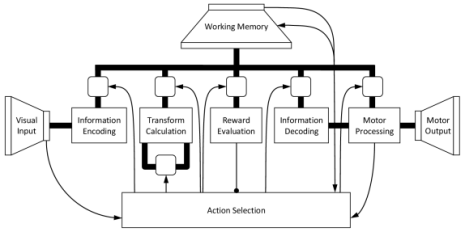One day, someone will build an electronic brain that will power an android, such that it behaves as a person. Before that can happen, we must first understand how the human brain operates. Plenty attempts have been made to digitally simulate a human brain, but one valiant effort is being attempted by a team of computational neuroscientists at the University of Waterloo.
Their Project Spaun is a digital brain comprised of 2.5 million virtual neurons. That’s just a fraction of the 100 billion that would be required to represent the real version, but enough to support some interesting visual tasks.
To create artificial intelligence, there are two general schools of thought: top-down and bottom-up. Bottom-up, such as what IBM is building with their Blue Brain Project, starts from scratch and attempts to build up digital neurons and synapses through training and machine learning, hoping to eventually reach the level of humans. Top-down essentially tries to program everything there is to be programmed, including ill-fated attempts at programming every single common sense rule.
The Spaun team characterizes its approach as top-down, although their approach, they say, is slightly different. They took what they know from the human brain, focusing on the fact that certain regions control certain functions. As such, and as shown by the architecture diagram below, the mechanical brain sends data through various functional units in order to better understand its visual input.

Team member Xuan Choo explains: “We took a different approach than most neural network models out there. Rather than have a gigantic network which is trained, we infer the functionality of the different parts of the model from behavioural data (i.e. we look at a part of the brain, take a guess at what it does, and hook it up to other parts of the brain).”
For example, when Spaun sees a number and is asked to replicate it, the machine processes the visual input and calls on its memory while selecting an action, much like how a person relies on memory to make decisions based on their sensory input.
“The basic run-down,” said Choo “of how it works is: It gets visual input, processes said visual input, and based of the visual input, decides what to do with it. It could put it in memory, or change it in some way, or move the information from one part of the brain to another, and so forth.”
It is important to note that the Waterloo team is not trying to build a computerized brain, but rather is using this simulation to better understand how the human version works. The brain processes information through transient electrical pulses along neurons, where the neurons’ electrical reading spikes when they are being used. The mechanical brain does that as well with one key exception: there is less regularity in the human brain’s energy level when the neurons spike.
With that being said, the Waterloo team is learning a significant amount about human cognition. “A big part of what comes out of our work is finding that some algorithms are very easy to implement in neurons, and other algorithms are not,” said Terrence Stewart.
In order to expand Spaun’s cognitive capacity, the team has been training it to recognize and reproduce handwritten numbers. Like a grade school student, it has moved from recognizing and writing the numbers to pattern recognition — for example, the next in a series such as 1 , 3, 5,… “Only the visual system in Spaun is trained, and that is so that it could categorize the handwritten digits,” noted Choo.
There are a couple of competing viewpoints on what the next challenge will be for the Waterloo team. Choo thinks the next major advancement will be to get Spaun to operate in real time. Stewart, who is confident that such operation will be a reality in about two years, is looking beyond that. “The next goals are all going to be to add more parts to this brain,” said Stewart. “There are tons of other parts that we haven’t got in there at all yet (especially long-term memory).”
Either way, for neuroscience enthusiasts and Singularity-seekers alike, Spaun is worth keeping an eye on.


























































